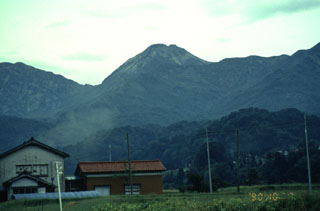Report on Niigata-Yakeyama (Japan) — April 1989
Scientific Event Alert Network Bulletin, vol. 14, no. 4 (April 1989)
Managing Editor: Lindsay McClelland.
Niigata-Yakeyama (Japan) Increased steaming, small ash eruption
Please cite this report as:
Global Volcanism Program, 1989. Report on Niigata-Yakeyama (Japan) (McClelland, L., ed.). Scientific Event Alert Network Bulletin, 14:4. Smithsonian Institution. https://doi.org/10.5479/si.GVP.SEAN198904-283090
Niigata-Yakeyama
Japan
36.921°N, 138.036°E; summit elev. 2400 m
All times are local (unless otherwise noted)
A white steam plume was rising from the volcano's upper E flank during observations by the staff of Takada Weather Station (from sites 10-20 km away) 1 May 1987-September 1988. Emissions gradually declined, and after a 9 November 1988 visit, no plume was observed.
Moderate steam emission was seen again on 30 March 1989, with a white vapor plume rising 100-150 m from 2 areas on the upper E flank. Steam from the upper NE flank rose about 30-50 m on 15 April. Four days later, steam with a small amount of ash was emitted to about 100-150 m above the upper E flank, the first sighting of a gray plume since May 1987. Observations from Sasagamine (about 8 km SE) on 26 April revealed gray plumes rising 250-300 m from many sites on the upper E flank. A 30 April steam plume, about 300-400 m high and blown 600 m by the wind (figure 2), was the highest since May 1987. Access to the volcano has been closed to tourists.
Geological Summary. Niigata-Yakeyama, one of several Japanese volcanoes named Yakeyama ("Burning Mountain"), is an andesitic-to-dacitic lava dome in Niigata prefecture in west-central Honshu, about 20 km from the coast. The volcano was constructed on a base of Tertiary mountains beginning about 3,100 years ago. Three major eruptions in the past 1,000 years have produced pyroclastic flows and lava flows that traveled mainly down the Hayakawa river valley to the N and NW. The first of these eruptions, in 887 CE (and possibly 989 CE), produced the Hayakawa pyroclastic flow, which reached the coast, and the massive Mae-yama lava flow, which traveled about 6.5 km down the Hayakawa river valley. The summit lava dome was emplaced during the 1361 CE eruption, and the last magmatic eruption took place in 1773 CE. Eruptive activity since 1773 has consisted of relatively minor phreatic explosions from several radial fissures and explosion craters that cut the summit and flanks of the dome.
Information Contacts: JMA.


